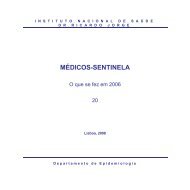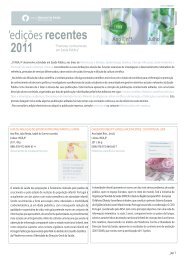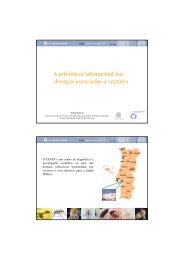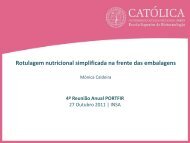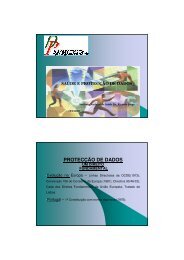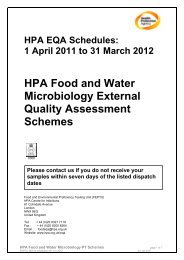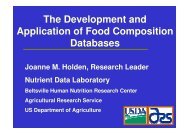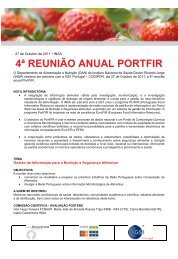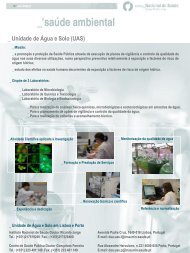European Society of Mycobacteriology - Instituto Nacional de Saúde ...
European Society of Mycobacteriology - Instituto Nacional de Saúde ...
European Society of Mycobacteriology - Instituto Nacional de Saúde ...
Create successful ePaper yourself
Turn your PDF publications into a flip-book with our unique Google optimized e-Paper software.
PP-28<br />
MULTIDRUG-RESISTANT TUBERCULOSIS<br />
Nuak, Joao; Ferreira, Danina; Carvalho, Teresa; Gomes, Maria Helena; Sarmento, Antonio<br />
Hospital S. Joao, Porto - Portugal<br />
Introduction<br />
Multidrug-Resistant Tuberculosis (MDRTB) is caused by M.tuberculosis (MT) resistant to at least Isoniazid (INZ) and<br />
Rifampin (RIF), and can be due to unsuitable or irregular treatment.<br />
Purpose<br />
To know the epi<strong>de</strong>miological and clinical characteristics <strong>of</strong> the disease in patients (pts) hospitalized with MDRTB in an<br />
Infectious Diseases Service.<br />
Patients And Methods<br />
Review <strong>of</strong> clinical records <strong>of</strong> pts with MDRTB. Diagnosis was based on drug susceptibility testing.<br />
Results<br />
Between 1996 and 2007, 16 pts had MDRTB. Eleven were male. Ages ranged between 27-40y(X=32.2±4.33). Fifteen<br />
(93.8%) had HIV infection (14 drug addicts; 1 sexual risk). One pt had pr<strong>of</strong>essional contact with MDRTB. The disease was<br />
only pulmonary in 7(44%) pt, disseminated in 5(31%), pulmonary and extra-pulmonary in 3(19%)-meningeal, lymph no<strong>de</strong>s<br />
(LN) and urine in one each pt; another pt had only meningeal disease. Eleven (69%) pts had previous irregular antituberculosis<br />
treatment. MT was isolated in sputum in 12/16 pt (75%); CSF in 5/6 pt (83%), bronchoalveolar lavage in 2/6(33%),<br />
blood in 3/6(50%), urine in 2/6(33%), LN in 2/6(33%), gastric aspirate and feces in one each. Most pts had MT isolated in<br />
more than one sample. All MT were resistant to INZ and RIF. Thirteen out <strong>of</strong> 16 pt (81%) were also resistant to streptomycine,<br />
6/12(50%) to pyrazinami<strong>de</strong>, 6/16(37%) to ethambutol, 5/12(42%) to rifabutine, 10/15(67%) to ethionami<strong>de</strong>,<br />
4/14(28%) to kanamycin, 4/13(31%) to <strong>of</strong>loxacilline, 3/7(43%) to PAS, 2/5(40%) to kapriomycine e 1/5(20%) to cyclocerin.<br />
In 4 pts MT was simultaneously resistant to at least three 2nd line drugs (XDRTB). Fifteen pts had medical treatment according<br />
to the drug susceptibilities testing. In two pts pneumectomy was performed. Eight pts died: One before diagnosis<br />
and 7 between 30-720 days <strong>of</strong> diagnosis. One pt survived for 6y. maintaining positive cultures <strong>of</strong> sputum <strong>de</strong>spite medical<br />
and surgical therapy. Two pts were treated for 18 months with clinical and radiological improvement, without evi<strong>de</strong>nce <strong>of</strong><br />
disease 1 and 5y. later. Five pts were lost to follow-up. One is on treatment with clinical and radiological improvement.<br />
Conclusion<br />
MDRTB is a serious public health problem. HIV, drug addiction and irregular treatment were important factors for its<br />
<strong>de</strong>velopment. Prognosis <strong>de</strong>pends on early <strong>de</strong>tection <strong>of</strong> drug resistance and institution <strong>of</strong> appropriate therapy. We emphasize<br />
the very high mortality.<br />
100 ESM 2009



